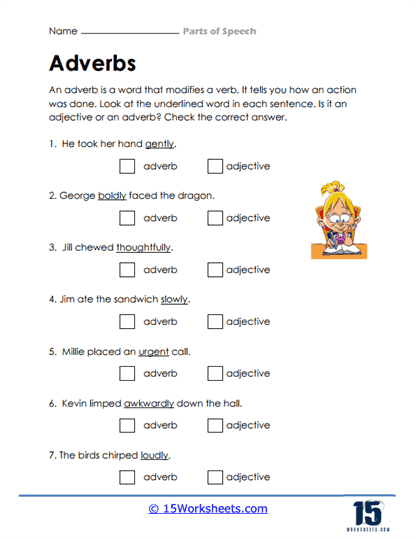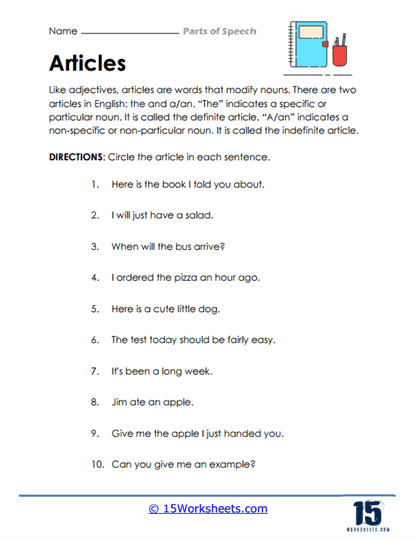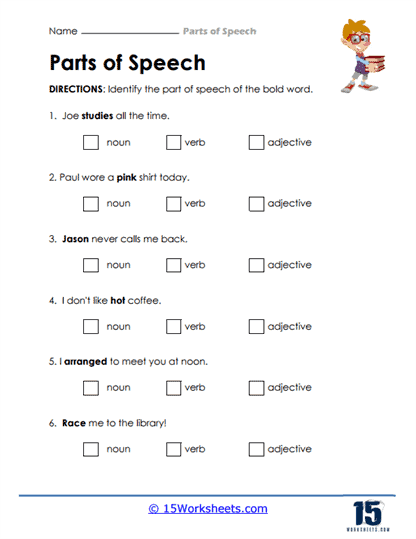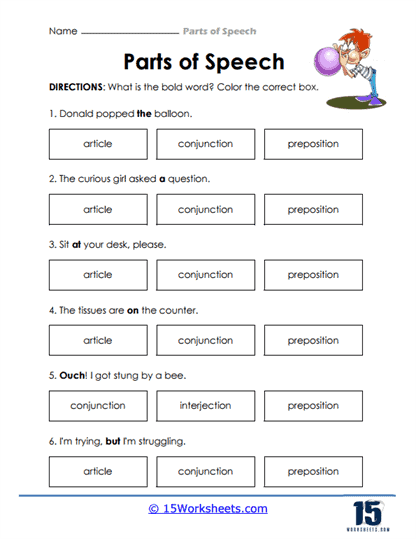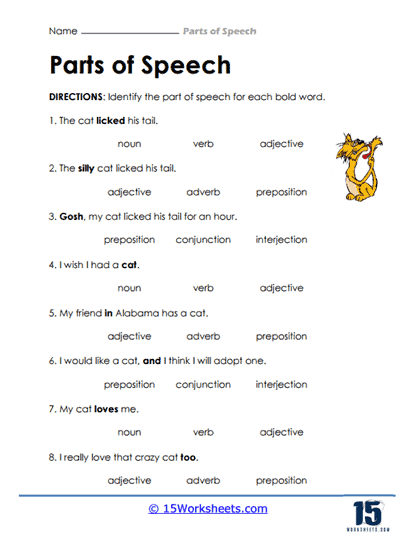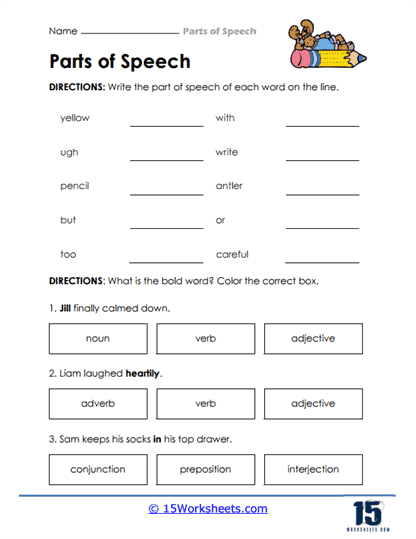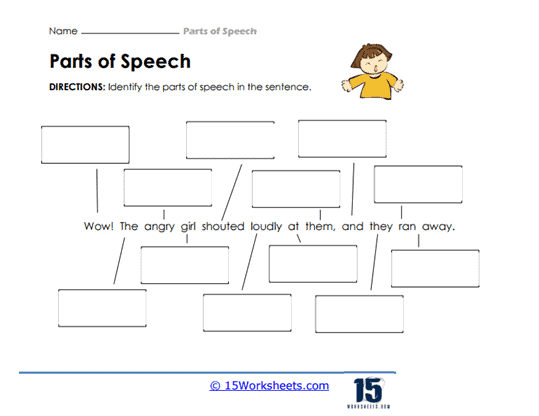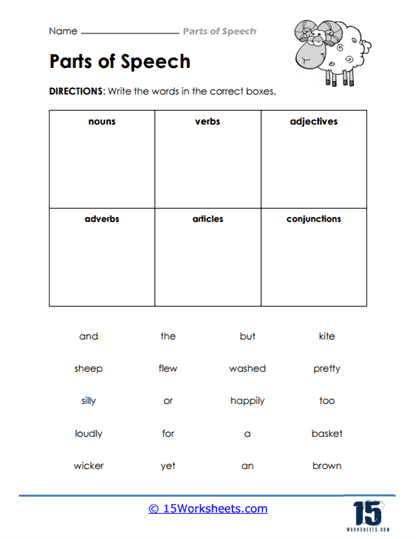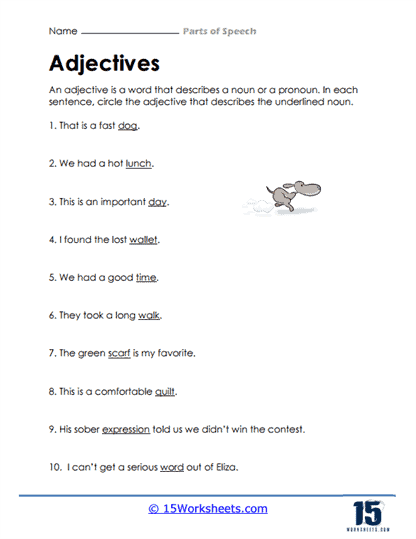Parts of Speech Worksheets
All About These 15 Worksheets
These Parts of Speech worksheets are educational resources that teachers can use to help their students understand the different parts of speech in the English language. These worksheets include exercises and activities that involve identifying and using various parts of speech in sentences.
These worksheets usually start with the definition of the part of speech being introduced and how they function in language. The exercises that follow are designed to help students distinguish between different types of parts of speech, such as nouns, verbs, adjectives, adverbs, pronouns, prepositions, conjunctions, articles, and interjections. They also help students understand the proper use of each type of part of speech in context.
They include activities that involve categorizing words according to their parts of speech, identifying the parts of speech of specific words in a sentence, and creating sentences using specific parts of speech. Through these worksheets, students will:
- Identify the noun by using pictures as context clues;
- Learn what different personal pronouns refer to;
- Expand their vocabulary on verbs;
- Distinguish an adjective from an adverb;
- Be familiar with various prepositions, conjunctions, interjections, and articles;
- And understand how each part of speech functions in a sentence and how to use them correctly.
These worksheets can be used in a variety of settings, including classrooms, homeschooling environments, and tutoring sessions. By using worksheets on Parts of Speech, teachers can help their students improve their understanding and use of various parts of speech, which can enhance their overall communication skills and writing ability.
What are the Parts of Speech and why do they matter?
The parts of speech in English are the basic building blocks of the language, and they are used to create sentences and express meaning. There are nine main parts of speech in English, which are:
- Noun – A noun is a word that represents a person, place, thing, or idea, such as “dog,” “city,” “love,” or “freedom.”
- Verb – A verb is a word that expresses an action or state of being, such as “run,” “sing,” “is,” or “were.”
- Adjective – An adjective is a word that describes or modifies a noun or pronoun, such as “red,” “happy,” “tall,” or “beautiful.”
- Adverb – An adverb is a word that modifies a verb, adjective, or other adverb, such as “quickly,” “very,” “loudly,” or “often.”
- Pronoun – A pronoun is a word that takes the place of a noun, such as “he,” “she,” “it,” or “they.”
- Preposition – A preposition is a word that shows the relationship between a noun or pronoun and other words in a sentence, such as “in,” “on,” “under,” or “beside.”
- Conjunction – A conjunction is a word that connects words, phrases, or clauses in a sentence, such as “and,” “but,” “or,” or “because.”
- Interjection – An interjection is a word or phrase that expresses strong emotion or surprise, such as “wow,” “ouch,” “hey,” or “oh.”
- Article – An article is a word used to specify or indicate the noun it precedes. There are two types of articles in English: “the,” which is a definite article used to refer to a specific noun, and “a” or “an,” which are indefinite articles used to refer to any one of a group of nouns.
Understanding the parts of speech is important for developing strong communication skills in English, as it helps to ensure that sentences are constructed correctly and convey the intended meaning. Aside from this, here are also several other particular benefits to teaching the various parts of speech in English to students:
- Developing Strong Writing Skills – Knowing the different parts of speech and their correct usage can help students to construct grammatically correct sentences and paragraphs, which is essential for effective writing.
- Enhancing Reading Comprehension – Understanding the parts of speech can help students to better comprehend the meaning of written texts, as they can identify how words and phrases are used within a sentence and their relationship to each other.
- Improving Vocabulary – Learning the different parts of speech can also help students to expand their vocabulary, as they can learn new words and their meanings based on their context and usage.
- Standardized Tests – Many standardized tests, such as the SAT, ACT, and TOEFL, assess students’ knowledge of the different parts of speech, so learning them can help students to achieve higher scores on these tests.




